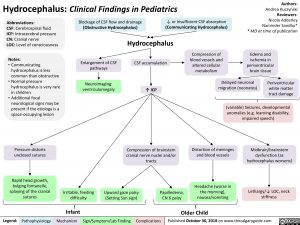Hydrocephalus: Clinical Findings in Pediatrics
Authors: Andrea Kuczynski Reviewers: Nicola Adderley Naminder Sandhu* * MD at time of publication
Edema and
ischemia in periventricular brain tissue
Abbreviations:
CSF: Cerebrospinal fluid ICP: Intracerebral pressure CN: Cranial nerve
LOC: Level of consciousness
Notes:
• Communicating hydrocephalus is less common than obstructive
• Normal pressure hydrocephalus is very rare in children
• Additional focal neurological signs may be present if the etiology is a space-occupying lesion
Pressure distorts unclosed sutures
Rapid head growth, bulging fontanelle, splaying of the cranial sutures
Blockage of CSF flow and drainage
(Obstructive Hydrocephalus)
↓ or insufficient CSF absorption
(Communicating Hydrocephalus) Hydrocephalus
Enlargement of CSF pathways
Neuroimaging: ventriculomegaly
CSF accumulation
↑ ICP
Compression of blood vessels and altered cellular metabolism
Delayed neuronal migration (neonates)
Periventricular white matter tract damage
(variable) Seizures, developmental anomalies (e.g. learning disability, impaired speech)
Compression of brainstem cranial nerve nuclei and/or tracts
Distortion of meninges and blood vessels
Headache (worse in the morning), nausea/vomiting
Midbrain/brainstem dysfunction (as hydrocephalus worsens)
Lethargy/↓ LOC, neck stiffness
Irritable, feeding difficulty
Upward gaze palsy (Setting Sun sign)
Papilledema, CN 6 palsy
Infant
Older Child
Legend:
Pathophysiology
Mechanism
Sign/Symptom/Lab Finding
Complications
Published October 30, 2018 on www.thecalgaryguide.com
Foundations
Systems
Other Languages
Pediatrics Pediatric Neurology Hydrocephalus: Clinical Findings in Pediatrics Hydrocephalus: Clinical Findings

